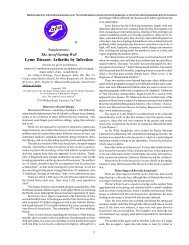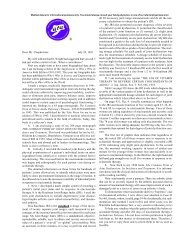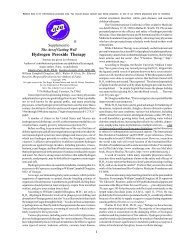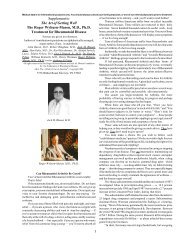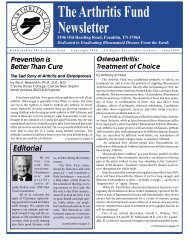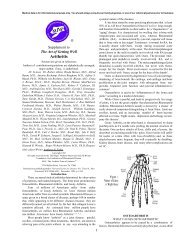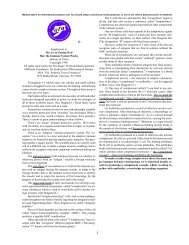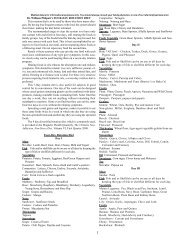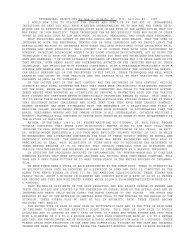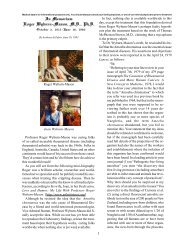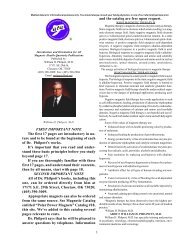Molybdenum for Candida albicans Patients and Other Problems
Molybdenum for Candida albicans Patients and Other Problems
Molybdenum for Candida albicans Patients and Other Problems
Create successful ePaper yourself
Turn your PDF publications into a flip-book with our unique Google optimized e-Paper software.
Medical data is <strong>for</strong> in<strong>for</strong>mational purposes only. You should always consult your family physician, or one of our referral physicians prior to treatment.<br />
the metabolism of the essential amino acid, threonine, is its<br />
conversion into acetaldehyde <strong>and</strong> then on into acetic acid <strong>for</strong><br />
eventual production of acetyl coenzyme A.<br />
Supplement to<br />
® The Art of Getting Well<br />
<strong>Molybdenum</strong> <strong>for</strong> <strong>C<strong>and</strong>ida</strong> <strong>albicans</strong><br />
<strong>Patients</strong> <strong>and</strong> <strong>Other</strong> <strong>Problems</strong><br />
Sources are given in references.<br />
Authors of contributions\quotations are alphabetically arranged;<br />
major author, if any, is underlined.<br />
Dr. George Miroff, Dr. Richard Mowles, Jon B.Pangborn,<br />
William H. Philpott, M.D./Responsible editor/writer Walter H.<br />
Schmitt, Jr., D.C.<br />
Copyright 1991<br />
All rights reserved <strong>for</strong> the author byThe Roger Wyburn-Mason <strong>and</strong> Jack M. Blount<br />
Foundation <strong>for</strong> the Eradication of Rheumatoid Disease<br />
AKA The Arthritis Trust of America ® ,<br />
7376 Walker Road, Fairview, Tn 37062<br />
Published originally in The Digest of Chiropractic Economics, 31:4, January-<br />
February, 1991, pp. 56-63, 29229 Six Mile Road, Livonia, Michigan 48152-3661, Phone<br />
(313) 427-5720, <strong>and</strong> is reprinted as it appeared with permission of the author <strong>and</strong><br />
Chiropractic News Publishing Company, Inc., courtesy of Keith A. Tosolt, Managing<br />
Editor.<br />
ABSTRACT: The essential trace element, molybdenum, (pronounced<br />
mo-lib'de-num) is discussed in relation to its various<br />
metabolic pathways. Diagnostic approaches <strong>for</strong> molybdenum include<br />
applied kinesiological procedures based on strong muscles<br />
weakening when a patient sniffs aldehydes, ammonia, or Clorox, or<br />
tastes sulfur-containing amino acids. <strong>Other</strong> patterns indicating a<br />
need <strong>for</strong> molybdenum are the same as would be seen in a need <strong>for</strong> iron<br />
<strong>and</strong>/or excess of copper. Each of these metabolic pathways are<br />
shown to be important in the problems of the <strong>C<strong>and</strong>ida</strong> <strong>albicans</strong><br />
patient, as well as other patients. Protocols <strong>for</strong> supplementation <strong>and</strong><br />
natural sources of molybdenum are given.<br />
INTRODUCTION: <strong>Molybdenum</strong> is an essential trace element<br />
in human nutrition which is understood about as well as it is<br />
pronounced. In fact, there is no laboratory testing which has been<br />
st<strong>and</strong>ardized <strong>for</strong> the evaluation of molybdenum. Although it has<br />
been measured in both blood <strong>and</strong> hair, the normal values <strong>for</strong> these<br />
tests have yet to be established, <strong>and</strong> although it is accepted as an<br />
essential nutrient <strong>for</strong> humans, there has yet to be a recommended<br />
daily allowance or minimum daily requirement officially established.<br />
However, its importance in numerous patients, including<br />
those with <strong>C<strong>and</strong>ida</strong> <strong>albicans</strong> allergy, has been paramount.<br />
<strong>Molybdenum</strong> has been studied both directly in the blood <strong>and</strong><br />
hair 1 , indirectly by looking at other metabolites which relate to the<br />
presence of molybdenum 2,3 <strong>and</strong> by applied kinesiological (A.K.)<br />
analysis by Dr. Richard Mowles 4 .<br />
<strong>Molybdenum</strong> is necessary <strong>for</strong> the function of at least three<br />
important enzymes in the body: 1) aldehyde oxidase <strong>for</strong> our bodies'<br />
h<strong>and</strong>ling of aldehydes it produces <strong>and</strong> those encountered in the<br />
environment; 2) xanthine oxidase <strong>for</strong> the conversion of purines into<br />
uric acid; <strong>and</strong> 3) sulfite oxidase <strong>for</strong> the conversion of irritating<br />
sulfites into harmless sulfates. In addition, molybdenum is found in<br />
many biological processes in conjunction with iron <strong>and</strong> is found to<br />
cause a response in AK indicators similar to that of iron. Also,<br />
molybdenum is an antagonist to copper <strong>and</strong> vice versa. Considering<br />
all of the above factors has led to our underst<strong>and</strong>ing of how<br />
molybdenum is usually a necessary adjunct to the treatment of<br />
<strong>C<strong>and</strong>ida</strong> <strong>albicans</strong> allergy patients <strong>and</strong> has speeded the recovery of<br />
most of these patients even above <strong>and</strong> beyond the effective natural<br />
procedures which were described in a previous paper by Mowles <strong>and</strong><br />
this author 5 .<br />
MOLYBDENUM AND ALDEHYDES: Chemical aldehydes<br />
are best known as fragrances. The body also produces various<br />
aldehydes as part of its normal metabolic pathways. One pathway in<br />
1<br />
Acetaldehyde is a particularly toxic substance which, in<br />
addition to being produced from threonine <strong>and</strong> ethanol, is a product<br />
of the metabolism (i.e. fermentation) of carbohydrate in yeast --<br />
hence, the <strong>C<strong>and</strong>ida</strong> connection. Acetaldehyde is thought to be the<br />
major source of tissue damage in alcoholics rather than ethanol<br />
itself. The conversion of acetaldehyde into acetic acid is shown in<br />
Figure 2. Note that this reaction requires NAD (niacinamide), <strong>and</strong><br />
aldehyde oxidase is dependent on FAD (riboflavin), iron (Fe), <strong>and</strong><br />
<strong>Molybdenum</strong> (Mo).<br />
<strong>C<strong>and</strong>ida</strong> <strong>albicans</strong> patients <strong>and</strong> any other patients who complain<br />
of sensitivities to various fragrances <strong>and</strong> airborne odors will<br />
be found to have a problem with an olfactory challenge with an<br />
aldehyde <strong>and</strong> will be found to be in need of one or more of the<br />
nutrients associated with the metabolism of aldehydes, that is<br />
niacinamide, riboflavin, iron <strong>and</strong>/or molybdenum. Mowles 4 had<br />
patients sniff a dilute source of <strong>for</strong>maldehyde <strong>and</strong> observed the<br />
results in muscle testing of patients. In 15 patient trials with<br />
weakening on smelling <strong>for</strong>maldehyde, 14 were found to strengthen<br />
on molybdenum. Our clinical procedure paralleled that of Mowles,<br />
although we used different sources of aldehydes.<br />
Our original investigation involved using nail polish remover<br />
(Cutex ® br<strong>and</strong>) as a source of acetone. We were attempting to use<br />
an olfactory challenge <strong>for</strong> ketones since transketolase enzyme is<br />
vitamin B 1<br />
(thiamine) dependent. We had per<strong>for</strong>med the functional<br />
blood test <strong>for</strong> red blood cell transketolase on a number of patients<br />
<strong>and</strong> found some of them to show a need <strong>for</strong> B 1<br />
. Knowing that nail<br />
polish remover is primarily acetone, we attempted olfactory challenging<br />
to observe the results. Eventually, we switched to using<br />
pure acetone <strong>for</strong> olfactory challenging because of the sporadic<br />
results we observed from using the nail polish remover.<br />
A close look at the contents of the Cutex bottle revealed that<br />
besides acetone, a fragrance <strong>and</strong> a food color had been added. It is<br />
useful here to mention when testing with sniffing acetone, a<br />
strengthening of weak muscles or a weakening of strong muscles<br />
has been demostrated to be associated with a need <strong>for</strong> vitamin B 1<br />
.<br />
The proper B 1<br />
tablet, either high synthetic doses or low, natural<br />
source, or occasionally both, when insalivated, will block the<br />
weakening response to sniffing acetone in those patients who show<br />
it, <strong>and</strong> will likewise mimic the strengthening response in that group<br />
of patients.<br />
Although we still occasionally use the nail polish remover as<br />
a screening test <strong>for</strong> acetone <strong>and</strong> B 1<br />
involvement, we now know that<br />
many of our original sporadic observations were due to the presence<br />
of a fragrance (i.e., an aldehyde) in the product. We obtained<br />
a source of benzaldehyde, which is the smell of almonds <strong>and</strong> quite
Medical data is <strong>for</strong> in<strong>for</strong>mational purposes only. You should always consult your family physician, or one of our referral physicians prior to treatment.<br />
pleasant. In the meantime, we had communicated with Mowles <strong>and</strong> but this patient showed none of the characteristic patterns which we<br />
found out about his results with <strong>for</strong>maldehyde. In an ef<strong>for</strong>t to find a rely on <strong>for</strong> diagnosis of this syndrome 5 . She will be able to return<br />
less offensive odor, we opted <strong>for</strong> the benzaldehyde. Further searching<br />
led to a source of acetaldehyde itself, <strong>and</strong> that is now our first off further infections.<br />
to normal tissue resistance following infection <strong>and</strong> be able to ward<br />
choice when challenging the aldehyde oxidase activity with olfactory<br />
testing.<br />
many symptoms. some of these symptoms seem to be directly<br />
The patients with aldehyde sensitivity have complained of<br />
When we initially screen a patient, we per<strong>for</strong>m several olfactory related to the aldehydes <strong>and</strong> others from different sources. It is<br />
challenges by having our patients sniff such substances as Clorox ®6 , difficult to differentiate which symptoms are aldehyde related in<br />
acetone, an aldehyde, <strong>and</strong> ammonia, which will be discussed later. most patients, but the most dramatic responses from controlling<br />
We observe <strong>for</strong> strengthening of weak muscles, <strong>and</strong> especially a aldehyde sensitivity have been in <strong>C<strong>and</strong>ida</strong> <strong>albicans</strong> patients, on<br />
weakening of strong muscles. In an aldehyde sensitive patient, there whom everything else had been tried. The addition of molybdenum,<br />
based on aldehyde olfactory sensitivity muscle testing has<br />
will be a generalized weakening of all of their muscles when they<br />
sniff an aldehyde. We have observed some patients who are sensitive resulted in turnarounds of our most difficult <strong>C<strong>and</strong>ida</strong> <strong>albicans</strong><br />
to one aldehyde <strong>and</strong> not to another, <strong>and</strong> although this is uncommon, patients. The most noticeable changes are seen in the sore, achy,<br />
it is useful to keep more than one source of pure or diluted pure sluggish, "flu-type" symptoms of which many <strong>C<strong>and</strong>ida</strong> patients<br />
aldehyde present, <strong>for</strong> use in ruling out an aldehyde problem in a complain. The energy returns, the generalized musculoskeletal<br />
difficult patient.<br />
achiness improves, <strong>and</strong> mental sluggishness disappear, <strong>and</strong> sinus<br />
When a patient weakens with sniffing an aldehyde, assume a <strong>and</strong> nasal congestion clears up. Based on these observations on<br />
problem with the aldehyde oxidase enzyme system. To further difficult patients, we now screen every <strong>C<strong>and</strong>ida</strong> <strong>albicans</strong> patient<br />
evaluate this pattern, check a muscle or muscles which are weak in with the aldehyde sniffing test <strong>and</strong> take appropriate measures<br />
the clear using oral insalivation of each of the four substances sooner rather than later in these patients. The addition of molybdenum,<br />
in particular, has been a great boon to us in h<strong>and</strong>ling the<br />
associated with the metabolism of aldehyde oxidase system: niacinamide,<br />
riboflavin, iron <strong>and</strong> molybdenum. We usually start with <strong>C<strong>and</strong>ida</strong> patient, <strong>and</strong> getting them out of whatever rut or vicious<br />
molybdenum because it is the most commonly found fact in our cycle the aldehyde sensitivity has put them into. <strong>Molybdenum</strong> is<br />
practice.<br />
also important in caring <strong>for</strong> a number of other metabolic problems<br />
When molybdenum, or one of the other three substances, associated with the <strong>C<strong>and</strong>ida</strong> patient, as well as other patients.<br />
strengthens the weak muscles, we then have the patient again sniff MOLYBDENUM AND AMMONIA METABOLISM:<br />
the aldehyde with the neutralizing substance in the mouth. Sometimes,<br />
one of the nutrients will strengthen a weak muscle but will not addition to <strong>for</strong>maldhyde 4 . There are many facets to olfactory<br />
Mowles' study included olfactory challenging with ammonia in<br />
negate the aldehyde sniff response. We only supplement the nutrient challenging with ammonia which have been discussed by this<br />
which both strengthens the weak muscle <strong>and</strong> negates the weakening author in his seminars <strong>and</strong> are the source of future papers 7 . Mowles<br />
response of the aldehyde sniff.<br />
chose to focus his study on the relationship of ammonia weakening<br />
<strong>Patients</strong> with aldehyde sensitivity will demonstrate a number of response to the strengthening response from molybdenum. In<br />
symptoms. The most severe cases we have observed are those twelve patient trials where the patient weakened on sniffing ammonia,<br />
seven of these patients were found to have weak muscles<br />
patients with systemic <strong>C<strong>and</strong>ida</strong> <strong>albicans</strong> allergy syndrome. Many of<br />
these patients are incredibly sensitive to any type of fragrance. This strengthen with insalivation of molybdenum.<br />
becomes easily understood in light of the idea that <strong>C<strong>and</strong>ida</strong> in the G.I. <strong>Molybdenum</strong> is necessary <strong>for</strong> the function of xanthine oxidase<br />
enzyme. Iron is also necessary <strong>for</strong> the function of this enzyme.<br />
tract, vagina, or elsewhere in the body is giving off acetaldehyde as<br />
part of its normal metabolism. The excess stress which this must put Xanthine oxidase converts hypoxanthine into xanthine <strong>and</strong> then<br />
on the aldehyde oxidase enzyme systems in the body's tissues leaves converts xanthine on into uric acid. (See Figure 3.) These reactions<br />
them unable to keep up with the extra dem<strong>and</strong>. Supplementation of are essential in the metabolism of purines. It follows then, that<br />
molybdenum <strong>and</strong>/or niacinamide, riboflavin, <strong>and</strong> iron will improve patients with low serum uric acid levels should be checked <strong>for</strong> a<br />
the patient's ability to h<strong>and</strong>le the <strong>C<strong>and</strong>ida</strong> generated aldehydes, as need <strong>for</strong> molybdenum (<strong>and</strong>/or iron).<br />
well as those encountered in the environment.<br />
When an aldehyde sensitivity exists, there is a considerable<br />
tissue irritation due to the buildup of these substances. It appears<br />
from our clinical observations that some patients fall into a vicious<br />
cycle of aldehyde sensitivity where there is a depletion of one or<br />
more of the aldehyde oxidase related nutrients which leads to an<br />
increase tissue irritation from <strong>C<strong>and</strong>ida</strong> produced aldehyde. This<br />
tissue irritation lowers tissue resistance which sets up vulnerability<br />
to future invasion by the <strong>C<strong>and</strong>ida</strong> <strong>albicans</strong> or other infectious agents<br />
reinitiating the cycle over again. This pattern often accompanies the<br />
"pseudoinfection syndrome" previously discussed by this author 6 ,<br />
<strong>and</strong> appears to be responsible, at least in part, <strong>for</strong> many patients with<br />
chronic vaginitis from a yeast infection.<br />
Uric acid is excreted in the urine <strong>and</strong> is one way in which the<br />
We have observed at least one patient who has been plagued body may rid itself of ammonia. In Figure 4, one can see that each<br />
with recurrent vaginal yeast infections, at least once monthly, <strong>for</strong> molecule of uric acid contains four nitrogen molecules. Since the<br />
many years. Every possible allopathic approach has been unsuccessful<br />
in controlling the recurrence of these infections. Mycostatin ammonia, <strong>and</strong> <strong>for</strong>mate, a lack of xanthine oxidase function could<br />
body can synthesize purines from amino acids, carbon dioxide,<br />
(Nystatin) as vaginal suppositories has been useful in controlling the presumably cause a back-up in the metabolism of purines <strong>and</strong> block<br />
acute infection, but the response is slow <strong>and</strong> has no effect on one pathway of utilization of ammonia. The ammonia from amino<br />
recurrence. We suspected systemic <strong>C<strong>and</strong>ida</strong> <strong>albicans</strong> involvement, acids which would otherwise be used in the synthesis of purines<br />
2
Medical data is <strong>for</strong> in<strong>for</strong>mational purposes only. You should always consult your family physician, or one of our referral physicians prior to treatment.<br />
may be backed up in the system. This would explain the observation Sulfites are used by the food industry as preservatives.<br />
that sniffing ammonia causes a weakening of some of these patients' Metabisulfite is used to keep fruits <strong>and</strong> vegetables looking fresh in<br />
muscles. In a number of patients weakening upon sniffing ammonia, grocery stores <strong>and</strong> restaurant salad bars. This substance has created<br />
the weakening will be neutralized by the insalivation of molybdenum,<br />
presumably due to its relationship to xanthine oxidase. (Occa-<br />
resulted in a few deaths. Asthmatics must be especially wary of this<br />
severe reactions in patients who are sensitive to it, <strong>and</strong> has even<br />
sionally iron will also neutralize the ammonia weakening effect, <strong>and</strong> substance since it will trigger an almost immediate severe asthma<br />
there are many other factors which must be considered in this attack.<br />
olfactory ammonia challenge.)<br />
One of our sulfite-sensitive patients thought he had been<br />
Because there are so many factors related to the ammonia poisoned <strong>and</strong> had such dyspnea that he felt like he was dying,<br />
olfactory challenge, it is convenient in ammonia sensitive patients to collapsing on a restaurant table following eating of a salad from a<br />
use a muscle which is weak in the clear <strong>for</strong> screening <strong>for</strong> the salad bar in which sulfite preservative was used. He eventually<br />
appropriate nutrients(s) If molybdenum strengthens the muscle pulled out of the asthma attack, but now he asks first about the use<br />
which is weak in the clear, it is held in the mouth while the ammonia of sulfites when eating out.<br />
is sniffed. Supplementation of molybdenum (or any other substance) Another patient in our practice simply avoids eating out<br />
is based on the nutrient first stengthening a weak muscle, <strong>and</strong> then altogether because of the fear of ingesting sulfites. Her reaction is<br />
negating the weakening effect previously induced by sniffing ammonia.<br />
arrhythmia, <strong>and</strong> complete exhaustion from sulfite contact. These<br />
extreme nasal <strong>and</strong> nasopharyngeal congestion, tachycardia <strong>and</strong><br />
patients will have weak muscles which respond to molybdenum,<br />
although their sensitivity to sulfites may or may not be affected by<br />
this supplementation, <strong>and</strong> avoidance of sulfite contact is usually<br />
recommended. Still another pathway, also shown in Figure 6, is the<br />
conversion of cysteine into what eventually is pyruvic acid <strong>and</strong><br />
sulfide ion.<br />
Ammonia sensitivity is related to many symptoms. The syndrome<br />
of hyperammonemia has been discussed by Pangborn 8 <strong>and</strong><br />
Philpott 9 <strong>and</strong> others. At least part of the concern with excess ammonia<br />
availability in the body is the amination of many substances<br />
which have neurotransmitter potential: <strong>for</strong> example, glutamic acid,<br />
when aminated becomes glutamine. Both substances have very<br />
different effects in the central nervous system. Likewise, in light of<br />
extra available ammonia, histadine will tend to be converted into<br />
histamine, aspartic acid will tend towards conversion into asparagine,<br />
<strong>and</strong> the availability of other amino acid putative neurotransmitter<br />
substances such as glycine may be affected. <strong>Molybdenum</strong><br />
deficiency may thereby have some pretty far-reaching effects in the<br />
metabolism of purines, ammonia metabolism, neurotransmitter activity,<br />
<strong>and</strong> possibly many other related pathways.<br />
MOLYBDENUM AND SULFITE METABOLISM: <strong>Molybdenum</strong><br />
is necessary <strong>for</strong> the function of the enzyme sulfite oxidase.<br />
This enzyme plays the important role in the conversion of potentially<br />
harmful sulfites to the harmless <strong>and</strong> useful sulfates in the body. (See<br />
Figure 5.) Sulfite oxidase is necessary <strong>for</strong> the eventual metabolism<br />
of sulfur groups in the sulfur amino acid metabolism which begins<br />
with the essential amino acid, methionine. This enzyme is also<br />
important in dealing with sulfites which are encountered dietarily or<br />
in the environment. Measurements of urinary sulfite excretion have<br />
been proposed as an indirect laboratory test to determine molybdenum<br />
status 10 .<br />
3<br />
The three pathways <strong>for</strong> the metabolism of sulfur-containing<br />
amino acids, starting with methionine, are summarzied in Figure 6.<br />
In one pathway <strong>for</strong> the eventual processing of these sulfur containing<br />
amino acids, a sulfite ion is released which must be converted<br />
into sulfate, using the molybdenum-dependent sulfite oxidase<br />
enzyme. Another pathway is the eventual conversion of cysteine<br />
into taurine. Still another pathway, also shown in Figure 6, is the<br />
conversion of cysteine into what eventually is pyruvic acid <strong>and</strong><br />
sulfide ion.<br />
What we have observed clinically does not exactly fit what we<br />
would expect to see based on the metabolism pathways in Figure<br />
6. A number of patients will demonstrate dramatic weakening of all<br />
their muscles when ingesting methionine which will be negated by<br />
the simultaneous insalivation of molybdenum. In other words, it
Medical data is <strong>for</strong> in<strong>for</strong>mational purposes only. You should always consult your family physician, or one of our referral physicians prior to treatment.<br />
appears that in a molybdenum requirement, the body's ability to of molybdenum are found in the liver, kidney (where xanthine<br />
metabolize methionine is blocked. This may be seen in amino acid oxidase is present) <strong>and</strong> the adrenal gl<strong>and</strong>s. High concentrations are<br />
profiles by an elevated methionine 1 . This would make sense in the also found in bone <strong>and</strong> skeletal muscle although, at present, Mo's<br />
case of a magnesium deficiency as can be seen in Figure 6. But in the functions in these tissues are unknown 13 .<br />
case of a need <strong>for</strong> molybdenum we would also expect to find a We have found muscle testing indicators <strong>for</strong> Mo to be the<br />
weakening from cysteine since the role of molybdenum is played same as <strong>for</strong> iron. This is especially true when a patient has<br />
beyond cysteine in the metabolic flow chart. We only occasionally previously shown an A.K. need <strong>for</strong> iron <strong>and</strong> still has the same<br />
see weakening from cysteine in these patients. We occasionally see indicator <strong>for</strong> iron despite supplementation. These patients usually<br />
strengthening from cysteine or no response from cysteine in these also respond to Mo. We speculate that, <strong>for</strong> whatever reason,<br />
patients, but we are surprised at the infrequency with which we possibly molybdenum's antagonist role to copper, to be discussed<br />
observe cysteine to cause weakness in these patients.<br />
in the next section, Mo enhances many of iron's roles. This might<br />
Some of these patients will show a strengthening response to include iron's hematopoietic role <strong>and</strong> its role in myoglobin in<br />
taurine. Taurine has been discussed in an earlier paper by this author muscles. Perhaps, these are some of Mo's unknown functions in<br />
in its function as a free radical scavenger <strong>for</strong> the free radical OCl bone <strong>and</strong> skeletal muscle.<br />
(hypochlorite ion or hypoclorous acid.) 6 In light of a molybdenum Identifying a need <strong>for</strong> molybdenum has solved several curious<br />
cases of apparent iron deficiency anemia when patients were<br />
requirement, we have observed some patients who weaken on<br />
sniffing Clorox who are taurine responders <strong>and</strong> who also have this non-responsive in spite of iron supplementation. We now consider<br />
weakening response negated by molybdenum insalivation. Although a potential <strong>for</strong> molybdenum whenever we observe a lowered red<br />
this does not make sense based on the biochemistry presented, there blood cell count, lowered hemoglobin, lowered hematocrit, or<br />
must be some sort of negative feedback mechanism when sulfite lowered mean cellular hemoglobin (MCH). We have not seen<br />
oxidase is unable to metabolize sulfites. This feedback must affect enough of these patients to prove this relationship, but our anecdotal<br />
experience is enough to make us suspect a need <strong>for</strong> molybde-<br />
the conversion of methionine, causing it to back up, thereby causing<br />
the weakening response to methionine we observe in some patients num any time we suspect or find a need <strong>for</strong> iron. We have also<br />
with a molybdenum requirement.<br />
observed Mo cause a response in the case of aerobic metabolism<br />
In a few difficult patients who fall into the "fast oxidizers" or through myoglobin <strong>for</strong>mation. <strong>Molybdenum</strong> has occasionally<br />
"over-oxidized" category, we find a generalized muscle weakness been seen to neutralize these aerobic muscle testing weaknesses in<br />
pattern when we first examine the patient. The use of the antioxidants some of our musculoskeletal patients.<br />
glutathione in combination with selenium has caused strengthening <strong>C<strong>and</strong>ida</strong> <strong>albicans</strong> is an anaerobic organism <strong>and</strong> there<strong>for</strong>e<br />
in a number of these patients who did not respond to water or a grows more readily in an anaerobic environment. Anything which<br />
multiple vitamin or mineral nutrient as recommended by Goodheart 11 . interferes with the ability of the body to carry oxygen to its tissues<br />
These patients always have symptoms of free radical pathology <strong>and</strong> may enhance the growth of <strong>C<strong>and</strong>ida</strong>. <strong>Molybdenum</strong>'s apparent<br />
are among the most difficult we see. Because of the nature of cysteine functions paralleling those of iron may aid in producing a higher<br />
being a part of the tripeptide, glutathione, <strong>and</strong> because of our level of tissue oxygenation <strong>and</strong> thereby decrease the anaerobic<br />
occasional observations of patients requiring cysteine <strong>for</strong> production environment in which <strong>C<strong>and</strong>ida</strong> flourishes.<br />
of taurine <strong>for</strong> OCl free radical quenching, we attempted to check two MOLYBDENUM AND COPPER: <strong>Molybdenum</strong> <strong>and</strong> copper<br />
are antagonists. Just as iron <strong>and</strong> molybdenum are synergists,<br />
of these multiple weakness patients with a combination of molybdenum<br />
(in place of glutathione) with selenium. We have seen a iron <strong>and</strong> copper are antagonists if they are not in balance with each<br />
combination of these two minerals cause a generalized strengthening other, so are molybdenum <strong>and</strong> copper antagonists. In patients who<br />
effect in two multiple weakness patients. One of these patients also demonstrate copper toxicity patterns, we have traditionally employed<br />
zinc <strong>and</strong> manganese to chelate the excess copper out of the<br />
responded to a glutathione-selenium combination <strong>and</strong> the other one<br />
responded only to the molybdenum-selenium combination. tissues. <strong>Molybdenum</strong> is also useful <strong>for</strong> this purpose. <strong>Molybdenum</strong><br />
<strong>C<strong>and</strong>ida</strong> <strong>albicans</strong> allergy [may be] due to the chronic, long antagonizes copper absorption <strong>and</strong> in a number of experiments in<br />
term stimulation of the immune system, free radical release, <strong>and</strong> animals, copper <strong>and</strong> molybdenum have been shown to be directly<br />
antioxidant depletion. Imagine the chemical stress a patient's tissues antagonistic to each other.<br />
must be under when constantly exposed to free radicals, sulfites, Mowles <strong>and</strong> I have observed an extremely high correlation in<br />
acetaldehyde, <strong>and</strong> ammonia, all of which have accumulated in the our practices of copper toxicity in patients with <strong>C<strong>and</strong>ida</strong> <strong>albicans</strong> 5<br />
tissues due to an unmet molybdenum requirement of the patient. Add as well as in women with menstrual <strong>and</strong> premenstrual disorders<br />
to this the other factors involved in the <strong>C<strong>and</strong>ida</strong> patient <strong>and</strong> it is easy from functional hormonal imbalances 14 . It is possible that our<br />
to see why <strong>C<strong>and</strong>ida</strong> can be difficult to treat, <strong>and</strong> why molybdenum geographical location (R.M.-Roanoke, Virginia, <strong>and</strong> W.S.-Chapel<br />
can be such a great help in treating these patients.<br />
Hill, North Carolina) is responsible <strong>for</strong> this correlation. However,<br />
MOLYBDENUM AND IRON METABOLISM: In 1981, we find such a consistent pattern of low iron-high copper that we<br />
this author reported the common observation of iron neutralizing suspect copper's antagonism of iron <strong>and</strong> the resultant tendency<br />
retrograde weakening of patients' muscles 12 . Mowles observed that toward an anaerobic environment <strong>for</strong> the yeast to grow as a major<br />
many retrograde type patients responded to molybdenum either in factor in these patients, as previously mentioned. [Editor's note: in<br />
conjunction with or separately from iron 4 . <strong>Molybdenum</strong> plays a the brewing industry, replacing copper vats with another metal<br />
synergistic role with iron in the body. Clinically we are observing resulted in brewer's yeast being unable to grow, or ferment barleyrice<br />
into beer.]<br />
that any time one might use iron, one may also find a need <strong>for</strong><br />
molybdenum.<br />
Occasionally, we see a patient who has <strong>C<strong>and</strong>ida</strong> <strong>and</strong> is low in<br />
<strong>Molybdenum</strong> <strong>and</strong> iron are related in a number of biological copper. This seems contradictory to our other findings unless it is<br />
processes other than xanthine oxidase <strong>and</strong> aldehyde oxidase. In remembered that copper plays an essential role in working with<br />
plants, there are iron-molybdenum dependent nitrogenase enzymes, iron when they are in balance. As we have observed a need <strong>for</strong> Mo<br />
<strong>for</strong> example, as well as several other areas which Mo <strong>and</strong> iron work in some iron non-responsive iron deficiency type anemias, others<br />
together in important roles 13 . In humans, the highest concentrations have reported a similar pattern of copper deficiency. Too much or<br />
4
Medical data is <strong>for</strong> in<strong>for</strong>mational purposes only. You should always consult your family physician, or one of our referral physicians prior to treatment.<br />
too little copper can interfere with iron's role in hematopoiesis. to creep its way into multiple nutrient <strong>for</strong>mulae by many companies,<br />
but the need <strong>for</strong> the addition of specific Mo supplementation<br />
When we identify a copper toxic patient, we look very closely<br />
<strong>for</strong> any indication to give molybdenum. This includes any of the is still a common finding even in patients on these multiple nutrient<br />
above parameters or simply testing any gamma-2 muscle weakness. supplements. With the growing awareness of <strong>C<strong>and</strong>ida</strong> <strong>albicans</strong><br />
Gamma-2 (patient-started) weakness implies systemic chemical <strong>and</strong> other metabolic disturbances which relate to the molybdenum<br />
imbalances which are monitored by supraspinal (e.g. hypothalamus) pathways, it is felt that a significant percentage of your patients may<br />
levels 15 <strong>and</strong> seem to be involved in all cases in which we find a need be helped in their recovery by identifying the need <strong>for</strong> <strong>and</strong><br />
<strong>for</strong> molybdenum.<br />
supplying the essential, but little known trace element, molybdenum.<br />
SOURCES AND DOSAGES OF MOLYBDENUM: The<br />
average adult intake of molybdenum in the U.S. has been variously SUMMARY OF MAJOR CLINICAL INDICATORS<br />
reported as 350 mcg <strong>and</strong> between 120 mcg <strong>and</strong> 140 mcg 13 . When a FOR MOLYBDENUM:<br />
patient requires molybdenum based on one or more of the parameters 1. Muscles weaken on sniffing an aldehyde (e.g. acetaldehyde,<br />
<strong>for</strong>maldehyde, benzaldehyde, etc.) <strong>and</strong> insalivation of Mo<br />
mentioned in this paper, it is always our policy to supplement the<br />
patient with molybdenum <strong>for</strong> a period of time. We initially recommend<br />
300 mcg. per day <strong>and</strong> continue this level <strong>for</strong> one to two months, 2. Muscles weaken on sniffing Clorox (hypochlorite) <strong>and</strong>/or<br />
neutralizes this weakness.<br />
depending on the patient's clinical response. We always insist that tasting methionine <strong>and</strong>/or cysteine <strong>and</strong> insalivation of Mo neutralizes<br />
this weakness.<br />
the patient taste (chew or suck) the supplement to activate the taste<br />
bud receptors which have direct input to the hypothalmus. After the 3. Muscles weaken on sniffing ammonia <strong>and</strong> insalivation of<br />
first month or two, <strong>and</strong> when the patient's condition has shown Mo neutralizes this weakness.<br />
improvement, we decrease the dosage to 200 mcg per day until the 4. Whenever iron is indicated, Mo might also be indicated,<br />
patient has taken the supplement <strong>for</strong> a total of four months. such as in: aerobic testing muscle weakness patterns; retrograde<br />
The length of time to supplement a nutrient can often be based position weakness patterns, low hemoglobing, RBC count, hematocrit,<br />
or MCH.<br />
on clinical judgment <strong>and</strong> symptom response. In the case of molybdenum<br />
(<strong>and</strong> a number of other nutrients, especially those which have 5. Whenever copper causes muscle weakness, Mo may be<br />
a relationship to red blood cells), however, we always maintain necessary to chelate out excess copper. Also discussed: If strong<br />
supplementation <strong>for</strong> a period of at least four months. This is based on muscles weaken or weak muscles strengthen on sniffing acetones,<br />
the suggesiton of Dr. George Miroff 15 who recommends that any this indicates a need <strong>for</strong> B 1<br />
.<br />
nutrient which is associated with hematopoiesis be taken <strong>for</strong> a long REFERENCS:<br />
enough period of time that each RBC in the body gets its full share. 1. Pfeiffer, Carl, "Newer In<strong>for</strong>mation on Essential Trace<br />
In other words, since the life of a RBC is 120 days, it is necessary to Elements," presentation at Health by Choice conference, Atlanta,<br />
take these nutrients <strong>for</strong> at least 120 days to ensure that the entire blood 1984. Recorded by Insta Tape, Inc., P.O. Box 1729, Monrovia, CA<br />
supply has had the advantage of this nutrient.<br />
91016-5749.<br />
We have observed a number of patients who took molybdenum 2. Pfeiffer, Carl, Mental <strong>and</strong> Elemental Nutrients, New Canaan,<br />
(or other nutrients which aid in RBC production <strong>and</strong>/or are taken up CT: Keats, 1975.<br />
by the RBC's only during hematopoiesis) <strong>for</strong> one or two months <strong>and</strong> 3. Pangborn, Jon B., "Functions of Taurine Metabolism,"<br />
became asymptomatic, only to have the symptoms return one or two presentation at International Academy of Preventative Medicine<br />
months later after stopping the supplement. Starting at 300 mcg <strong>and</strong> conference, Chicago, 1983. Recorded by Insta Tape, Inc. Op.Cit.,<br />
gradually reducing the dosage over four months time period has <strong>and</strong> Technical Memor<strong>and</strong>um 5: Taurine, August, 1983.<br />
proven successful in our practice. In some difficult patients, we 4. Mowles, Richard, "A clinical Study Investigating the<br />
continue supplementation as long as they are symptomatic at a 100 Diagnostic Screening <strong>and</strong> Application of the Trace Mineral <strong>Molybdenum</strong><br />
in Applied Kinesiology," I.C.A.K. Collected Papers,<br />
to 200 mcg level.<br />
It is important to note that in cattle, molybdenum excess has Summer, 1985.<br />
been shown to decrease fetal growth 1 . Although no studies have 5. Mowles, Richard <strong>and</strong> Schmitt, Walter H., Jr., "An Applied<br />
indicated this in humans, we usually stop molybdenum supplementation<br />
in our pregnant patients, just to be on the safe side. If the Chiropractic Econimics, 28:4, January-February, 1986, p. 133.<br />
Kinesiological Approach to <strong>C<strong>and</strong>ida</strong> <strong>albicans</strong> Allergy," Digest of<br />
obvious need <strong>for</strong> molybdenum returns, we will again supplement 6. Schmitt, Walter H., Jr., "The Clorox Test," I.C.A.K. Collected<br />
Papers, Summer, 1985.<br />
this nutrient, but at 100 mcg or less as a precaution. Since there is no<br />
recognized st<strong>and</strong>ard <strong>for</strong> Mo need, we must rely on good clinical 7. Schmitt, Walter H., Jr., "Manipulating Body Chemistry<br />
judgment regarding dosage.<br />
Seminar," St. Louis, October 1985. Tapes available from A.K.S.P.,<br />
After a period of four months, we stop Mo supplementation if 1926 Overl<strong>and</strong> Drive, Chapel Hill, NC 27514.<br />
the patient is asymptomatic. We recommend that the patient consume<br />
more Mo containing foods, if they are not already doing so. Hyperammonemia," International Academy of Preventive Medi-<br />
8. Pangborn, Jon B., "The Amino Acid Biochemistry of<br />
Foods which are high in molybdenum are shown below in order of cine Conference, Las Vegas, fall 1981. Recorded by Insta Tape,<br />
their molybdenum concentrations 1 .<br />
Inc., Op. Cit.<br />
Grains: Buckwheat, wheat germ, barley oats.<br />
9. Philpott, William H. <strong>and</strong> Dwight K. Kalita, Victory over<br />
Vegetables: lima beans, canned beans, soybean meals, lentils, Diabetes, New Canaan, CT: Keats, 1983.<br />
green beans.<br />
10. Sohler, Arthur," <strong>Molybdenum</strong>, Its Metabolism <strong>and</strong> Role<br />
Liver <strong>and</strong> sunflower seeds are also high in molybdenum. as a Micronutrient." Academy of Orthomolecular Psychiatry 12th<br />
Since adding the diagnostic protocols <strong>for</strong> Mo in our office, we anniversary symposium. New York, 1983.<br />
have found scores of patients who showed a need <strong>for</strong> this essential 11. Goodheart, George, Personal communication. Summer,<br />
trace element. The remarkable repsonse in symptoms in patients with 1983.<br />
<strong>C<strong>and</strong>ida</strong> <strong>albicans</strong> as well as other difficult patients has caused us to 12. Rajagopalan, <strong>Molybdenum</strong> in Biochemistry of Essential<br />
check each new patient <strong>for</strong> this mineral. <strong>Molybdenum</strong> is beginning Trace Elements, ed. by Earl Frieden. New York: Plenum Press,<br />
5
Medical data is <strong>for</strong> in<strong>for</strong>mational purposes only. You should always consult your family physician, or one of our referral physicians prior to treatment.<br />
1984.<br />
7-10 50-150 1.0-2.0<br />
14. Mowles, Richard, "A Clinical Investigation of Premenstrual<br />
Syndrome <strong>and</strong> the Correlation with Copper," I.C.A.K. Col-<br />
Adults 75-250 1.5-3.0<br />
11+ 75-250 1.5-2.5<br />
lected Papers, Summer, 1983.<br />
15. Schmitt, Walter H., Jr., "Muscle Testing as Functional<br />
Blood Plasma Values (Lener & Bibr, 1984)<br />
Neurology," I.C.A.K. Collected Papers, January, 1986.<br />
16. Miroff, George, director Monroe Medical Research Laboratories.<br />
Southfield, N.Y. Personal communication 1984. Engl<strong>and</strong>, males 0.08 ng +/-0.3 ng/g<br />
US Population 5.0-157.3 ng/g<br />
* Pronunciation of molybdenum is mo-lib-de-num.<br />
Females<br />
1.2 – 0.5 ng/g<br />
Table 1:<br />
<strong>Molybdenum</strong> Intake, ESADD, Blood,<br />
Food Sources, Benefits<br />
Copyright by Stephan Cooter, Ph.D.<br />
<strong>Molybdenum</strong> is not abundant in the Earth’s crust or in seawater.<br />
Average soil contains only 1.5 mg per kilogram. Normal seawater<br />
contains only 0.1 mg per liter. Drinking water can contain more<br />
or less at 0-6.2 mg/liter, <strong>and</strong> mineral spring water contains 2.31-<br />
3.31 mcg per liter, less than tap water.<br />
<strong>Molybdenum</strong> is present in all bacterial, plant <strong>and</strong> animal tissues<br />
since 3 ubiquitous enzymes necessary <strong>for</strong> life require molybdenum<br />
<strong>for</strong> enzymatic processes. Because of that, the burning of fossil<br />
fuels derived from plant/animal material puts molybdenum in the<br />
air <strong>and</strong> water, affecting our daily intake. Urban air can contain as<br />
much as 10-30 mcg per cubic meter of air while rural air contains<br />
much less at 0.1-3.2 mcg/cubic meter. In steel <strong>and</strong> molybdenum<br />
roasting plants, workers can be exposed to as much as 1-19 mg of<br />
molybdenum per cubic meter of air, which is associated with goutlike<br />
symptoms, unless protective breathing masks are worn (Lener<br />
& Bibr, 1984).<br />
<strong>Molybdenum</strong> Intake <strong>and</strong> Excretion<br />
Category Age Copper Intake Excretion<br />
mg Mo mcg Mo mcg<br />
Food US adult 3-5 Intake 335<br />
Water US adult 2.8<br />
Air US adult 0.1<br />
Urine US adult 190<br />
Feces US adult 125<br />
Perspiration US adult 20<br />
Total 337 335<br />
All Sources UK Adult 94-162 No data<br />
Hospitalized <strong>Patients</strong> 250-1,000 No data<br />
Normal Values All Ages 210-460 No data<br />
Dietary factors influencing intake: Supplemental copper <strong>and</strong><br />
molybdenum taken at the same time combine <strong>and</strong> are excreted in<br />
the urine. Sulfur reduces absorption of molybdenum by blocking<br />
protein carriers <strong>and</strong> increasing excretion of molybdenum at 400-<br />
500 mg/l of water, used in Russian metallurgy plants to prevent Mo<br />
intoxication where excessive amounts are present in the air. High<br />
protein diets block absorption of molybdenum <strong>and</strong> enhance excretion.<br />
On the other h<strong>and</strong>, high carbohydrate diets enhance absorption<br />
<strong>and</strong> retention of molybdenum. (Roschik & Lukashev, 1978; Lener<br />
& Bibr, 1984; http://www.imoa.org.uk/imoadata/THERAPY.HTM)<br />
National Research Council Estimated Safe <strong>and</strong> Adequate<br />
Daily Dietary Intakes 1989<br />
Category Age Mo mcg Copper mg<br />
Infants 0-0.5 15-30 0.4-0.6<br />
0.5—1 20-40 0.6-0.7<br />
Children <strong>and</strong> Adolescents 1-3 25-50 0.7-1<br />
4-6 30-75 1.0-1.5<br />
6<br />
Blood donors<br />
Hospital Personnel<br />
<strong>Patients</strong> with<br />
degenerative<br />
diseases<br />
<strong>Patients</strong> undergoing<br />
treatment<br />
Pregnancy,<br />
12-19 weeks<br />
Pregnancy, labor<br />
1.8 ng/g<br />
3.4 ng/g<br />
1.2 ng/g<br />
7.2 +/ - .3 ng/g<br />
129.5 ng/g<br />
338.5 ng/g<br />
Food Sources<br />
Even though all foods contain atomic amounts of molybdenum<br />
since all cells require molybdenum in enzymatic processes,<br />
few foods contain substantial amounts of molybdenum that affect<br />
dietary intake significantly. Diets emphasizing meat <strong>and</strong> other animal<br />
sources produce low dietary intakes, with the exception of<br />
milk product diets. Good sources are milk products, the leafy portions<br />
of vegetables but not the root, legumes, cauliflower, liver,<br />
<strong>and</strong> whole grains. One Danish study found that the only food intake<br />
enhancing blood levels of molybdenum was butter. Tea contains<br />
trace amounts, coffee none. Distilled alcoholic beverages<br />
contain none; beer, wine, <strong>and</strong> Scotch contain trace amounts. A<br />
theoretical diet where the staples might consist largely of legumes<br />
<strong>and</strong> leafy vegetables could lead to excessive intake of molybdenum.<br />
Soil concentrations <strong>and</strong> conditions affect the levels found in<br />
foods (Lener & Bibr, 1984). Organic vegetables contain 50% to<br />
1000% more trace minerals than conventionally grown produce.<br />
Synthetic fertilizers discourage the mineralization of plants <strong>and</strong><br />
lower macronutrient quality. Organic food can be 8 times as high<br />
in macronutrients, according to one r<strong>and</strong>om sampling in a Chicago<br />
study; twice as high in other studies (Cooter, 1995; Heltman,<br />
1997).<br />
Leaf vegetables 2-26 mcg per kilogram<br />
Legumes 1,000-6,080 mcg per kilogram<br />
Cauliflower 1,150-2,260 mcg per kilogram<br />
Liver 200 mcg per kilogram<br />
Whole grains 200-485 (Buckwheat is the highest; barley<br />
medium; corn lowest)<br />
Potential Benefits of <strong>Molybdenum</strong> Enriched<br />
Soils <strong>and</strong> Diets<br />
(http://www.imoa.org.uk/imoadata/physi/MOLY.HTM & /<br />
THERAPY.HTM & BIOCHEM.HTM; Lener & Bibr, 1984;<br />
Roschik & Lukashev, 1978; Schmitt, 1991; Cooter, 1993)<br />
High molybdenum levels in soil<br />
Lower cavities (caries) incidence in populations of Engl<strong>and</strong>,<br />
Columbia, New Guinea, South Africa, Hungary, Ohio<br />
150-200 mg molybdenum per liter of water<br />
Caries inhibition in rats
Medical data is <strong>for</strong> in<strong>for</strong>mational purposes only. You should always consult your family physician, or one of our referral physicians prior to treatment.<br />
Soil <strong>Molybdenum</strong> enrichment, possibly the supplementation of vitamin<br />
C <strong>and</strong> Mo in humans; Mo supplementation in rats & mice<br />
Lower incidence of esophageal cancer, dysplasia, <strong>and</strong> mortality<br />
rates; lowered carcinogenic nitrosamine content in plants; protective<br />
against nitrosamines in rats; reverses throat cancers in rats;<br />
cures mammary tumors in mice; reduces GI-tract/rectum cancer<br />
incidence in animals<br />
Adequate molybdenum<br />
Stronger bone <strong>for</strong>mation<br />
Enhancement of phosphorous metabolism: decreased excretion<br />
of calcium & phosphorous, increased deposition in bone; enhances<br />
retention of potassium & iodine in plasma, but may decrease uptake<br />
of iodine by thyroid<br />
<strong>Molybdenum</strong> supplementation (amounts to be determined by orthomolecular<br />
physician, average 100-300 mcg/day <strong>for</strong> 3 months, gradually<br />
reduced <strong>and</strong> replaced by food sources)<br />
Enhances enzymatic activity of xanthinase, nitrogenase, alcohol<br />
dehydrogenase, detoxifies sulfites, enhances antioxidant uric acid<br />
production, protects against aldehyde/aromatic chemicals such<br />
as perfume <strong>and</strong> <strong>for</strong>maldehyde, alleviates premenstrual symptoms<br />
caused by copper overload, alleviates symptoms of c<strong>and</strong>idiasis<br />
<strong>Molybdenum</strong> supplementation<br />
Synergistic with iron in red blood cells <strong>and</strong> helpful in resolving<br />
iron deficient anemias that do not respond to iron alone<br />
<strong>Molybdenum</strong> supplementation at high experimental levels in mice<br />
<strong>for</strong> short periods of time<br />
Reverses diabetes, normalizes blood sugar levels, restores defective<br />
insulin production, enhances coenzyme A activity in diabetic<br />
mice<br />
<strong>Molybdenum</strong> supplementation <strong>and</strong> experimental tetrathiomolybdate<br />
chelation therapy<br />
Protects against mercury, lead, cadmium, copper poisoning in<br />
animal studies, may reduce zinc levels<br />
Tetrathiomolybdate, experimental chelation therapy<br />
Effective cure <strong>for</strong> Wilson’s Disease showing neuropyschiatric<br />
symptoms in human studies <strong>and</strong> LEC rats without side effects or<br />
neurological degeneration<br />
<strong>Molybdenum</strong> soil enrichment<br />
Enhances Axobacter chroococcum & other soil bacterial fixation<br />
of nitrogen<br />
Produces lush green productive plants at normal levels; cures<br />
yellows <strong>and</strong> curbits; excessive liming can inhibit plant growth <strong>and</strong><br />
produce copper deficiency in ruminant animals, moose, deer, cattle,<br />
sheep, <strong>and</strong> horses<br />
7<br />
Personal note: I was hospitalized <strong>for</strong> pneumonia <strong>and</strong> partial<br />
kidney failure <strong>for</strong> six days in May 2001. The consequence of being<br />
given one steroidal drug induced diabetes in me <strong>for</strong> the duration of<br />
the treatment. I had been given insulin shots twice a day to compensate.<br />
On the second day, I took one 100 mcg tablet of molybdenum<br />
to see if would help. My blood sugar levels normalized each day of<br />
three days I ingested one 100 mcg tablet, <strong>and</strong> the insulin shots were<br />
discontinued. This may have enormous practical application to diabetics<br />
who must monitor their blood sugar levels <strong>and</strong> take insulin<br />
shots.<br />
Table 2:<br />
<strong>Molybdenum</strong> Deficiency <strong>and</strong> Toxicity<br />
Copyright by Stephan Cooter, Ph.D.<br />
<strong>Molybdenum</strong> deficiency has not been found in free living human<br />
beings, but has been encountered in patients undergoing longterm<br />
parenteral IV nutrition unless 350 mcg of ammonium molybdate<br />
has been included in the nutritional <strong>for</strong>mula. Deficiency symptoms<br />
include tachycardia, headache, mental disturbances, <strong>and</strong> finally<br />
coma (Sardesai, 1993).<br />
There are also very rare instances of children born with defective<br />
molybdenum dependent enzymes, sulfite oxidase <strong>and</strong> xanthine<br />
dehydrogenase. Only 3 of such instances have been reported.<br />
This condition is characterized by infantile seizures, myoclonus,<br />
abnormal muscle tone, spastic symptoms, facial shape abnormalities,<br />
ocular lens abnormalities, mental retardation, brain atropy,<br />
<strong>and</strong> homocystinuria. Life expectancy is very short unless the defective<br />
gene lacking a molybdenum cofactor is only sulfite oxidase<br />
<strong>and</strong> does not include xanthine dehydrogenase. A low sulfur<br />
diet has been promising in one case of defective sulfite oxidase<br />
enzymes. <strong>Other</strong>wise, such children do not survive, <strong>and</strong> supplemental<br />
molybdenum does not change the outcome, nor have other<br />
attempts at treatment affected the outcome (Endres et al., 1988;<br />
Shih et al., 1977).<br />
<strong>Molybdenum</strong> has low toxicity <strong>for</strong> humans <strong>and</strong> is rarely found<br />
outside of the <strong>for</strong>mer USSR mining <strong>and</strong> metallurgy industries where<br />
protective breathing masks were not worn to prevent the inhalation<br />
of molybdenum containing dusts <strong>and</strong> fumes. A similar circumstance<br />
has been reported <strong>for</strong> artists in metal sculpture who use<br />
steel rods in their work. Rare instances of gout-like symptoms <strong>and</strong><br />
headaches have been reported in artists who do not wear respiratory<br />
protection <strong>and</strong> ventilate their working area (Lesser & Weiss,<br />
1985). Also, patients who must undergo long-term hemodialysis<br />
treatments experience dialysis caused arthritis from excessive molybdenum<br />
after many treatments (Hozokawa,1994).<br />
There are also rare instances of molybdenum toxicity <strong>for</strong> ruminant<br />
animals, cattle, sheep, horses, moose, <strong>and</strong> deer, which have<br />
a higher requirement <strong>for</strong> copper intake <strong>and</strong> a lower requirement<br />
<strong>for</strong> molybdenum. This condition is known as molybdenosis or<br />
copper deficiency. In humans, copper deficiency has never been<br />
encountered, including areas where the soil <strong>and</strong> food are low in<br />
copper content (Roschik & Lukashev, 1978).<br />
However, there are two towns in Armenia where the soil contains<br />
excessive molybdenum <strong>and</strong> dietary intakes from the food<br />
grown in the region average 10-15 mg per day of molybdenum. In<br />
this circumstance, gout-like symptoms are also prevalent in 18-<br />
31% of the adult population after life-time exposures to these high<br />
levels. In test areas where the copper intake was also high, this<br />
condition does not develop. In India, where the sorghum staple<br />
consumed contains 1.5 mg of molybdenum dietary intake per day,<br />
children growing up in this area develop genu valgum, knockknees,<br />
a bone de<strong>for</strong>mity, after years of intake. The soil in the region<br />
also contains unusually high amounts of fluorine, which contributes<br />
to the problem (Lener & Bibr, 1984). In other areas where<br />
molybdenum daily intake is as much as 350 mcg, this condition<br />
does not develop.<br />
<strong>Molybdenum</strong> Levels in Populations Studies<br />
Influencing factors: Supplemental copper <strong>and</strong> molybdenum<br />
taken at the same time combine <strong>and</strong> are excreted in the urine. Sulfur<br />
reduces absorption of molybdenum by blocking protein carriers<br />
<strong>and</strong> increasing excretion of molybdenum at 400-500 mg/l of<br />
water, used in Russian metallurgy plants to prevent Mo intoxication<br />
where excessive amounts are present in the air. High protein<br />
diets block absorption of molybdenum <strong>and</strong> enhance excretion. On<br />
the other h<strong>and</strong>, high carbohydrate diets enhance absorption <strong>and</strong><br />
retention of molybdenum. (Roschik & Lukashev, 1978; Lener &<br />
Bibr, 1984; http://www.imoa.org.uk/imoadata/THERAPY.HTM).<br />
<strong>Molybdenum</strong> Normal Deficient Toxic Result Remedy<br />
Soil 0.2-5mg/kg >0.2mg/kg Normal: Soil enrichment;<br />
Linxian, Healthy Supplementation<br />
South Africa,<br />
plant<br />
high throat
Medical data is <strong>for</strong> in<strong>for</strong>mational purposes only. You should always consult your family physician, or one of our referral physicians prior to treatment.<br />
cancer<br />
Armenian<br />
soil: 2 towns Soil: Gout-like Higher<br />
77mg/kg symptoms, copper intake<br />
Diet: 10-15 bone<br />
mg/day de<strong>for</strong>mities,<br />
Edema, skin<br />
flushing<br />
India Normal Excess Mo Knock-knees; Lowered Mo<br />
sorghum in sorghum genu Intake: no<br />
350mcg/d 1.5 mg/d Valgum more than<br />
350 mcg<br />
in children<br />
New Zeal<strong>and</strong> 0.03 ppm Xanthine Mo soil<br />
lambs in soil Disease, enrichment<br />
renal calculi<br />
Australia, Deficient Impaired bone/ Feed<br />
US, Chicks Mo in feed cartilage supplement<br />
<strong>for</strong>mation 0.5-2.5 Mg/kg<br />
Sweden, Somerset, 6 mg/kg Teart, diarhea, Supplemental<br />
Kern Co. soil weight addition of<br />
cattle, horses, from fly & hair loss, copper<br />
sheep, moose ash, depigmentation, to feed<br />
industrial anemia,<br />
pollution, sterility<br />
excessive<br />
liming<br />
Azerbaidz-han, lambs 2.5x> 15-39% enzootic Reversed<br />
Mo/Cu ataxia ratio of<br />
ratio<br />
Cu to Mo<br />
Swiss Alps, Engadin, 30 mcg/l Malmagliar: Supplemental<br />
lambs of water weight loss, copper addition<br />
anorexia,<br />
diarrhea<br />
Precautionary Labels <strong>and</strong> Warnings<br />
The International <strong>Molybdenum</strong> Association (IMOA) has conducted<br />
extensive tests on molybdenum toxicity <strong>for</strong> bacteria, algae,<br />
fish, <strong>and</strong> rats <strong>and</strong> found that all toxicity levels are above levels that<br />
the European Union requires precautionary labels <strong>and</strong> warnings <strong>for</strong>.<br />
You can easily access the data at: (http://www.imoa.uk/hse.htm) or<br />
at (http://www.imoa.org.uk/) <strong>and</strong> click on “Health, Safety & the<br />
Environment.” For humans, it would take many cases, not bottles,<br />
of supplements at one time to produce acute toxicity. According to<br />
Pfeiffer (1978) the only consequence of a possible massive dosage<br />
at one time would be increased tension in the muscles of back, hip,<br />
<strong>and</strong> thighs.<br />
High doses of 1.5 milligrams per day of molybdenum supplements<br />
have been taken by US adult males <strong>for</strong> a period of 24 days<br />
without adverse consequence. The study concluded that it was safe<br />
to take such an amount <strong>for</strong> a period equal to or greater than 24 days<br />
(Turnlund, 1995). It should be emphasized this study was of adult<br />
men <strong>and</strong> did not include children at this dosage level, nor did it<br />
include pregnant women, or humans with gout.<br />
This dosage level is known to begin to dump excess accumulation<br />
of copper in the urine, which is not harmful in itself. However,<br />
if continued <strong>for</strong> long periods of time, it is believed that this level<br />
would eventually produce a conditioned copper deficiency<br />
(Deosthale & Gopalan, 1974). In Indian children, this level of dosage<br />
produces bone de<strong>for</strong>mities after long-term intake. However, such<br />
a dosage might be a promising dietary approach to Wilson’s Disease<br />
<strong>for</strong> adult men <strong>and</strong> women under the supervision of a knowledgeable<br />
orthomolecular physician, but as far as I know, has not been attempted.<br />
Much higher doses have been attempted with animal studies<br />
involving metal poisoning <strong>and</strong> cancer <strong>for</strong> short periods of time<br />
without adverse events. Applications to humans have not been attempted<br />
in the data I have reviewed. However, experimental molybdenum<br />
cancer drugs <strong>and</strong> chelation therapy drugs <strong>for</strong> Wilson’s Disease<br />
are in the early stages of clinical trials with very promising<br />
results (Kopf-Maier, 1994).<br />
8<br />
Even though the IMOA suggests no precautionary warnings<br />
are necessary <strong>for</strong> any molybdenum product, from industrial grade<br />
molybdenum compounds to dietary compounds, I do believe two<br />
cautions are in order.<br />
1. Do not take molybdenum supplements above the Estimated<br />
Adequate <strong>and</strong> Safe levels during pregnancy since high doses<br />
have produced lower birth weight in all species studied, except<br />
under the direct supervision of a knowledgeable orthomolecular<br />
physician (See <strong>Molybdenum</strong> Tables: Appendix B. Schmitt (1991),<br />
a clinician who uses molybdenum supplements in his practice, will<br />
not use supplements of molybdenum at all during pregnancy because<br />
of this finding in animal studies. (See “<strong>Molybdenum</strong> Tables”<br />
<strong>for</strong> unanswered questions about rises in blood molybdenum levels<br />
during pregnancy <strong>and</strong> labor. <strong>Molybdenum</strong> blood levels double<br />
above normal levels, but the implications of this are still unclear<br />
to me.)<br />
2. Taking molybdenum supplements may worsen symptoms<br />
<strong>for</strong> people diagnosed with gout since uric acid production is enhanced.<br />
Speculations<br />
I have searched <strong>for</strong> in<strong>for</strong>mation, without success, on population<br />
studies <strong>for</strong> Climax, Colorado, the location of the largest molybdenum<br />
mine in the world. There I hoped to find evidence that<br />
would confirm data <strong>and</strong> add to in<strong>for</strong>mation which is not complete<br />
about Armenian <strong>and</strong> Indian exposures to high levels. In Climax,<br />
Colorado, the tap water <strong>and</strong> ground water contain very high levels<br />
of molybdenum. I would expect to find the same incidence of goutlike<br />
symptoms, but lowered incidence of throat, <strong>for</strong>estomach, colon,<br />
<strong>and</strong> rectal cancers, lowered incidence of diabetes, no health<br />
problems associated with lead, cadmium, <strong>and</strong> mercury poisoning,<br />
the absence of Wilson’s Disease among other things (see <strong>Molybdenum</strong><br />
Tables: Appendix B). Cancer, diabetes, Wilson’s Disease,<br />
heavy metal poisoning incidence were not among the issues studied<br />
in either Armenia or India.



